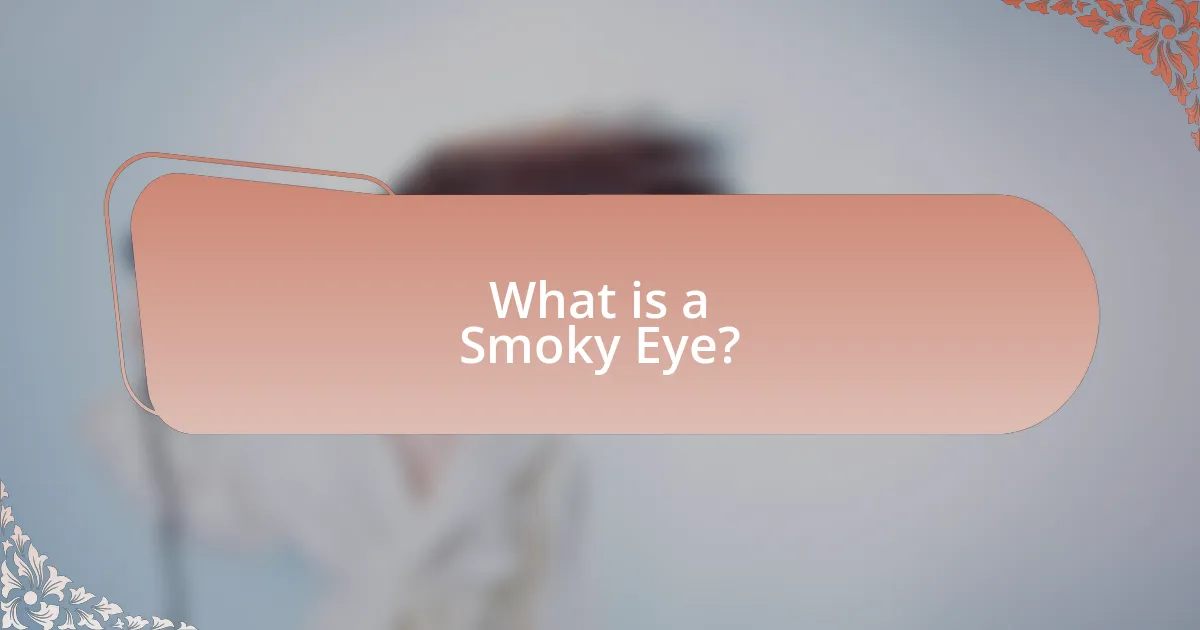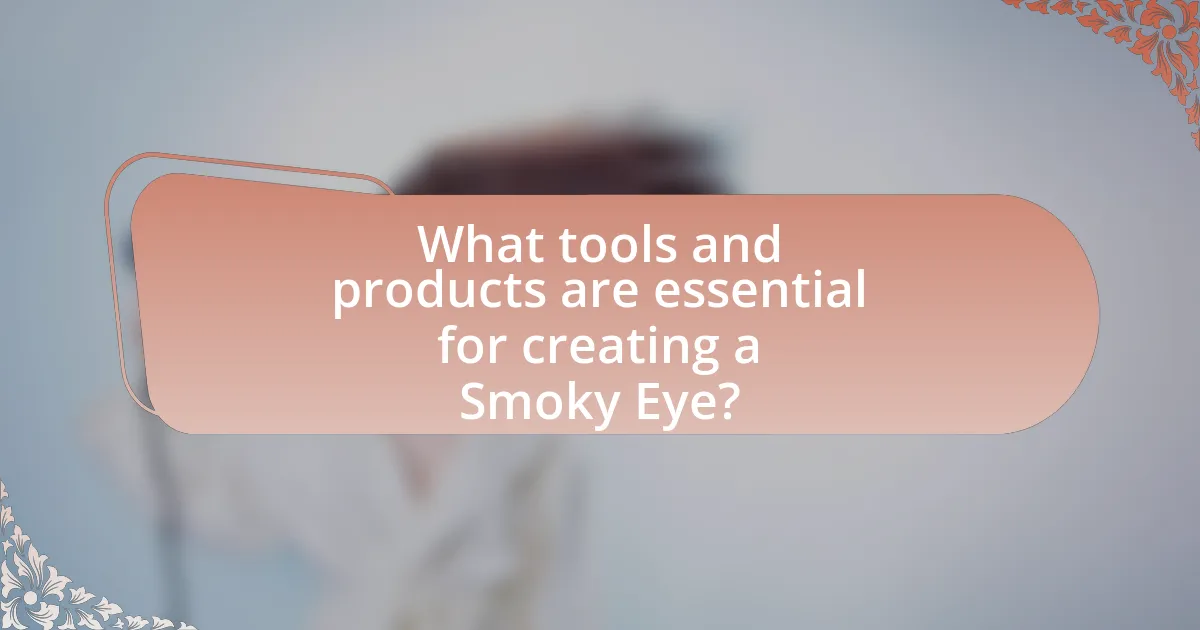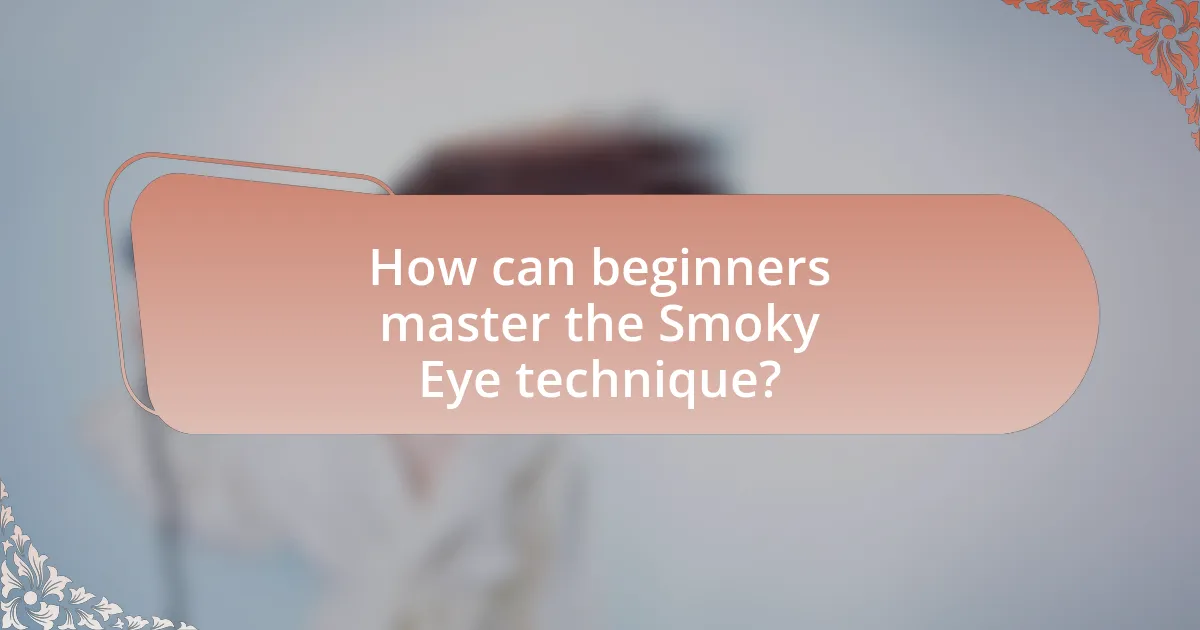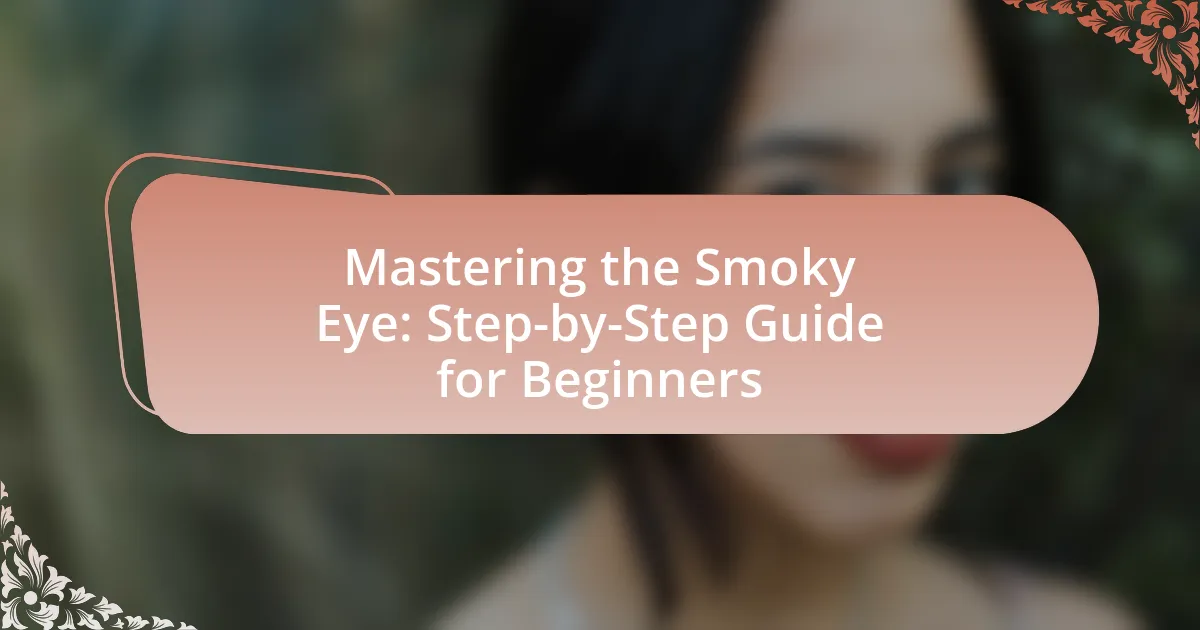The article focuses on mastering the Smoky Eye makeup technique, providing a comprehensive step-by-step guide tailored for beginners. It covers the origins and evolution of the Smoky Eye, key characteristics, essential tools and products, and application techniques. Additionally, it highlights common mistakes to avoid, tips for customization based on occasions, and best practices for achieving a long-lasting look. This structured approach aims to equip readers with the knowledge and skills necessary to create a flawless Smoky Eye.

What is a Smoky Eye?
A smoky eye is a makeup technique characterized by the blending of dark eyeshadow, typically black or gray, with lighter shades to create a sultry, smoky effect around the eyes. This style enhances the eyes’ depth and drama, making them appear more prominent. The technique often involves the use of eyeliner and mascara to further define the eyes, contributing to the overall bold look. The smoky eye has been a popular choice in makeup artistry for decades, often associated with glamorous evening looks and special occasions.
How did the Smoky Eye trend originate?
The Smoky Eye trend originated in the 1920s, primarily influenced by the glamorous looks of silent film actresses. This makeup style gained popularity as it emphasized the eyes, creating a dramatic effect that complemented the bold aesthetics of the era. The trend was further popularized in the 1960s by icons like Twiggy and later by celebrities in the 1990s, solidifying its status as a timeless makeup technique.
What cultural influences shaped the Smoky Eye look?
The Smoky Eye look is shaped by various cultural influences, primarily from ancient Egypt, where kohl was used to accentuate the eyes for both aesthetic and protective purposes. This practice evolved through the ages, with the dramatic eye makeup seen in the 1920s flapper culture and Hollywood glamour further popularizing the look. Additionally, the influence of various fashion movements, such as punk and grunge in the 1980s and 1990s, contributed to the modern interpretation of the Smoky Eye, emphasizing a bold and edgy aesthetic. These historical contexts illustrate how the Smoky Eye has been a canvas for cultural expression across different eras.
How has the Smoky Eye evolved over time?
The Smoky Eye has evolved from a simple, dark eye makeup technique into a versatile and sophisticated look embraced by various cultures and fashion trends. Initially popularized in the 1920s by silent film stars who used heavy eyeliner and dark shadows to create dramatic effects, the Smoky Eye gained mainstream attention in the 1960s with icons like Twiggy and Sophia Loren, who showcased softer, blended edges. Over the decades, the technique has diversified, incorporating a range of colors and finishes, from matte to shimmer, allowing for personalized interpretations. Today, the Smoky Eye is not only a staple in evening makeup but also adapted for daytime looks, reflecting contemporary beauty standards and the influence of social media, where tutorials and variations proliferate.
What are the key characteristics of a Smoky Eye?
A Smoky Eye is characterized by its blended, sultry appearance that typically features dark eyeshadow shades, often black or deep gray, combined with lighter tones to create depth. The technique involves applying a darker shade along the eyelid and blending it upwards and outwards, often accompanied by eyeliner to enhance the look. This style is designed to create a dramatic effect, emphasizing the eyes and providing a sense of allure. The use of various textures, such as matte and shimmer, further enhances the overall impact of the Smoky Eye, making it a popular choice for evening and special occasions.
What colors are typically used in a Smoky Eye?
The colors typically used in a Smoky Eye are black, gray, and dark brown. These shades create the signature smoky effect by providing depth and intensity. Additionally, lighter shades like white, cream, or soft beige are often used as highlights to enhance the look. The combination of these colors allows for a gradient effect, which is essential for achieving a well-blended Smoky Eye.
How does the application technique affect the Smoky Eye look?
The application technique significantly influences the Smoky Eye look by determining the intensity, blending, and overall finish of the makeup. Proper techniques, such as using a dense brush for the initial application and a fluffy brush for blending, create a seamless gradient that enhances the depth of the eye. Additionally, the order of application—starting with a primer, followed by darker shades on the lid and lighter shades on the brow bone—ensures a well-defined yet soft appearance. Studies in makeup artistry emphasize that blending techniques can either enhance or detract from the desired smoky effect, as uneven application can lead to harsh lines rather than a smooth transition.

What tools and products are essential for creating a Smoky Eye?
To create a Smoky Eye, essential tools and products include an eyeshadow palette with dark shades, a blending brush, an eyeliner pencil or gel, mascara, and a primer. The eyeshadow palette should contain at least one deep color, such as black or dark gray, to achieve the smoky effect. A blending brush is crucial for seamlessly blending the eyeshadow to avoid harsh lines. Eyeliner, whether pencil or gel, defines the eyes and enhances the smoky look, while mascara adds volume and length to the lashes, completing the eye makeup. A primer helps the eyeshadow adhere better and last longer, ensuring a polished finish.
What makeup products do you need for a Smoky Eye?
To achieve a Smoky Eye, you need an eyeshadow palette with dark shades, a blending brush, an eyeliner, mascara, and a primer. The eyeshadow palette typically includes colors like black, gray, and deep browns to create depth and intensity. A blending brush is essential for seamlessly merging the colors, while eyeliner defines the eyes and enhances the smoky effect. Mascara adds volume and length to the lashes, completing the look. A primer ensures that the eyeshadow adheres well and lasts longer throughout the day.
What types of eyeshadows work best for a Smoky Eye?
The best types of eyeshadows for a Smoky Eye are matte and shimmer finishes in dark shades such as black, charcoal, deep brown, and navy. Matte eyeshadows provide a solid base and help create depth, while shimmer eyeshadows add dimension and highlight. These finishes allow for blending and layering, essential for achieving the desired smoky effect. The combination of these shades enhances the overall look, making it more dramatic and captivating.
How do different eyeliners contribute to the Smoky Eye effect?
Different eyeliners contribute to the Smoky Eye effect by providing varying levels of intensity, blendability, and texture. Gel eyeliners, for instance, offer a rich pigmentation that can be easily smudged for a softer look, while pencil eyeliners allow for precise application and can also be blended to create depth. Liquid eyeliners, on the other hand, deliver a bold line that can enhance the dramatic aspect of the Smoky Eye. The combination of these eyeliners, when layered and blended properly, creates the signature smoky effect characterized by a gradient of color and a sultry finish.
What tools are necessary for achieving a perfect Smoky Eye?
To achieve a perfect Smoky Eye, essential tools include an eyeshadow palette with dark and neutral shades, a blending brush, a flat shader brush, an eyeliner pencil or gel, and a mascara. The eyeshadow palette provides the necessary colors to create depth and dimension, while the blending brush ensures a seamless transition between shades. The flat shader brush is used for applying color to the eyelid, and the eyeliner pencil or gel defines the eyes, enhancing the smoky effect. Finally, mascara adds volume and length to the lashes, completing the look.
What brushes are best for blending in a Smoky Eye?
The best brushes for blending in a smoky eye are a fluffy blending brush, a pencil brush, and a flat shader brush. A fluffy blending brush, such as a tapered blending brush, is essential for softening harsh lines and seamlessly blending eyeshadow colors. A pencil brush allows for precise application in the crease and lower lash line, while a flat shader brush is ideal for packing on color to the lid. These brushes are commonly recommended by makeup artists for achieving a smooth, blended look in smoky eye makeup.
How do applicators differ in their impact on the Smoky Eye look?
Applicators significantly influence the Smoky Eye look by determining the intensity, blending, and precision of the application. For instance, a flat brush deposits color more densely, creating a bold effect, while a fluffy brush allows for softer blending, resulting in a more diffused appearance. Additionally, sponge applicators can pack on pigment effectively, which is ideal for achieving a dramatic look, whereas pencil applicators provide control for detailed work along the lash line. The choice of applicator directly affects the overall finish and depth of the Smoky Eye, as different tools yield varying levels of opacity and blending capabilities.

How can beginners master the Smoky Eye technique?
Beginners can master the Smoky Eye technique by following a structured approach that includes selecting the right products, applying them in layers, and blending effectively. First, beginners should choose a good quality eyeshadow palette with complementary shades, typically including a base color, a darker shade for the smoky effect, and a highlighter. Next, they should apply a primer to ensure longevity and vibrancy of the colors.
The application process begins with the base color on the eyelid, followed by the darker shade in the crease and outer corner, which should be blended seamlessly to avoid harsh lines. Using a clean blending brush is crucial for achieving a smooth transition between colors. Finally, adding a highlighter to the brow bone and inner corner of the eye enhances the overall look.
Practicing these steps consistently will help beginners refine their technique, as the Smoky Eye relies heavily on blending and layering. According to makeup artists, mastering this technique can take time, but with patience and practice, beginners can achieve a professional-looking Smoky Eye.
What are the step-by-step instructions for creating a Smoky Eye?
To create a Smoky Eye, follow these step-by-step instructions:
- Start with a clean, primed eyelid to ensure the makeup adheres well and lasts longer.
- Apply a neutral eyeshadow as a base color across the entire eyelid to create an even canvas.
- Choose a dark eyeshadow, such as black or deep gray, and apply it to the outer corner of the eyelid, blending it inward towards the crease.
- Use a medium-toned eyeshadow, like a taupe or brown, to blend the edges of the dark shadow, creating a gradient effect.
- Apply a lighter shade, such as champagne or ivory, to the inner corner of the eye and the brow bone to highlight and open up the eyes.
- Line the upper lash line with a black eyeliner, smudging it slightly for a softer look, and apply eyeliner to the lower lash line as well.
- Finish with several coats of mascara on both the upper and lower lashes to enhance the smoky effect.
These steps provide a structured approach to achieving a classic Smoky Eye look, which is popular in makeup artistry for its dramatic and sultry appearance.
How do you prepare your eyelids for a Smoky Eye application?
To prepare your eyelids for a Smoky Eye application, start by applying an eyeshadow primer to create a smooth base and enhance the longevity of the makeup. This step is crucial as it prevents creasing and ensures that the eyeshadow adheres better to the eyelids. According to makeup experts, using a primer can increase the wear time of eyeshadow by up to 12 hours, making it an essential part of the preparation process. After applying the primer, set it with a light, neutral eyeshadow to further ensure a seamless application of darker shades.
What is the best order for applying products in a Smoky Eye look?
The best order for applying products in a Smoky Eye look is as follows: start with an eyeshadow primer, then apply a base eyeshadow, followed by a darker eyeshadow on the lid, blend a transition shade into the crease, apply eyeliner, and finish with mascara. This sequence ensures that the colors blend seamlessly and enhances the overall depth of the smoky effect. Using an eyeshadow primer helps to create a smooth canvas and prolongs the wear of the eyeshadows, while layering darker shades builds intensity and dimension, which is essential for achieving a classic smoky eye.
What common mistakes should beginners avoid when creating a Smoky Eye?
Beginners should avoid using too many colors when creating a Smoky Eye, as this can lead to a messy and uncoordinated look. Sticking to a limited color palette, typically two to three shades, helps maintain a cohesive appearance. Additionally, beginners often make the mistake of not blending properly; blending is crucial for achieving a seamless transition between colors. Another common error is applying too much product, which can overwhelm the eye area; using a light hand allows for buildable intensity. Lastly, neglecting to use a primer can result in the eyeshadow fading or creasing throughout the day, so applying a good primer is essential for longevity.
How can over-application affect the Smoky Eye outcome?
Over-application can lead to a messy and unrefined Smoky Eye outcome. When too much product is used, it can create harsh lines and an overly dark appearance, which detracts from the intended sultry effect. Additionally, excessive application can cause the eyes to look smaller and more closed off, rather than enhancing their natural shape. Proper blending becomes difficult with over-applied products, resulting in a lack of gradient and depth that is essential for a successful Smoky Eye look.
What tips can help prevent a messy Smoky Eye look?
To prevent a messy Smoky Eye look, start by using an eyeshadow primer to create a smooth base that enhances color adherence and longevity. This step minimizes creasing and smudging, which are common issues with smoky eyes. Additionally, applying eyeshadow in thin layers allows for better control over intensity and blending, reducing the risk of overwhelming darkness. Using a clean blending brush to soften edges ensures a seamless transition between colors, which is crucial for achieving a polished appearance. Finally, setting the look with a translucent powder can help lock in the eyeshadow and prevent fallout, further maintaining the integrity of the Smoky Eye throughout the day.
What are some tips for perfecting your Smoky Eye technique?
To perfect your Smoky Eye technique, start by using a primer to create a smooth base for your eyeshadow, which enhances longevity and vibrancy. Next, select a combination of dark and light eyeshadows; apply the dark shade on the eyelid and blend it upwards towards the crease for a seamless transition. Utilize a small, dense brush for precise application and a fluffy brush for blending to achieve a soft, smoky effect. Additionally, incorporating eyeliner along the lash line and smudging it can intensify the look. Finally, finish with mascara to open up the eyes and complete the smoky effect. These steps are supported by makeup artists who emphasize the importance of blending and layering for a flawless finish.
How can you customize your Smoky Eye for different occasions?
To customize your Smoky Eye for different occasions, adjust the intensity and color palette based on the event. For daytime looks, use softer shades like taupe or light brown with a subtle blend, while for evening events, opt for darker colors such as charcoal or black for a more dramatic effect. Additionally, incorporating shimmer or metallics can enhance the look for formal occasions, whereas matte finishes are suitable for casual settings. This approach aligns with makeup artistry principles, which emphasize adapting techniques to suit varying contexts and lighting conditions.
What are the best practices for maintaining a long-lasting Smoky Eye?
To maintain a long-lasting Smoky Eye, use a high-quality eyeshadow primer to create a smooth base that enhances color longevity and prevents creasing. Applying the primer ensures that the eyeshadow adheres better and lasts throughout the day. Additionally, selecting long-wear or waterproof eyeshadows can significantly improve durability, as these formulas are designed to resist fading and smudging. Setting the eyeshadow with a translucent powder or a matching eyeshadow can further lock in the look, providing extra hold. Finally, using a setting spray specifically formulated for makeup can help to seal the entire eye look, ensuring it remains intact for hours.


